|
Documentaries
Press
|
Rated 1.31/5
|

| Province: | Cusco |
| Location: | Capital of the province of Cusco, in the valley of the Huataney River in the southeast of the Andes, 3.400m above sea level. |
| Population: | about 400.000 inhabitants |
| Weather: | year av. 11° C, rain season Nov-March, dry season April-Oct. |
| Inside this page | To do and to visit | ||||||||||||||||
|---|---|---|---|---|---|---|---|---|---|---|---|---|---|---|---|---|---|
|
|
Cusco is the former capital of Tahuaninsuyo, the center of the Empire of the Four Regions and the "Navel of the world". From this city unfurled one of the most remarkable empires in the history of mankind. The Incas expanded their frontiers in less than one hundred years from the North of Quito in Ecuador to Santiago de Chili far South. In eastern direction they reached Argentina. Although the Incas are not well known in the western world, they were bigger than many ancient cultures intensively studied.
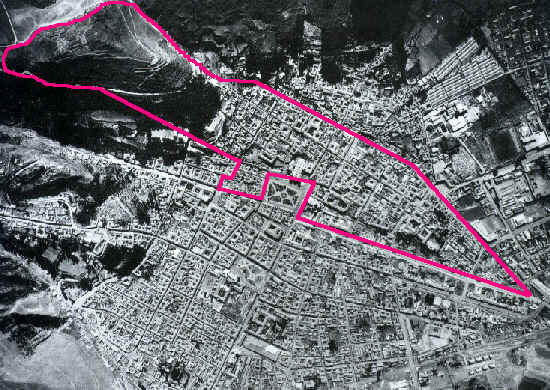
![]()
History and location
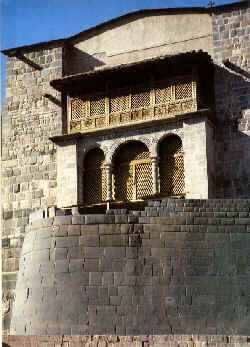 Cusco or Qosqo was
built at 3.400m in the shape of an enormous puma (see
picture above right). The body of the puma contained the most important palaces,
temples and governmental buildings while the fortress just outside the city, known
as Sacsayhuamán, formed
the head of this sacred animal. The square between the legs of the puma is the Plaza de Armas.
Cusco or Qosqo was
built at 3.400m in the shape of an enormous puma (see
picture above right). The body of the puma contained the most important palaces,
temples and governmental buildings while the fortress just outside the city, known
as Sacsayhuamán, formed
the head of this sacred animal. The square between the legs of the puma is the Plaza de Armas.
The city today is a strange mixture of Inca architecture and Spanish-Moorish colonial style. Unfortunately, the Spanish destroyed most of the temples in Cusco for building catholic churches. Inside the Santa Domingo (see picture left above) you can still visit the temples built in name of the natural elements as lightning, rain, Moon (Quilla), Sun (Inti), wind, etc. Most of these enormous palaces were built for every new Sapa Inca (the emperor) to performance his duty and do still exist. Some of them are turned into museums.
The legend tells us that the first Sapa Inca Manco Capac and his royal wife Mama Occllo received the assignment of the God of the Sun the Inti itself. They established the capital city of a new empire where a golden staff sunk in the ground and they managed to improved life of the people living in this part of the world. The Spanish arrived in Cusco late 1533 and were astonish by the beauty of the capital city. Eyewitnesses described the place as a city of gold and light. Streets were quiet, the Incas had no horses and the biggest domestic animal was the llama which can't be used to pull any kind of cart. Street life was quiet because only the inhabitants on sandals walked there. Every street was clean and had two canals: one as sewerage and on the other side of the street a canal with fresh and clean river water.
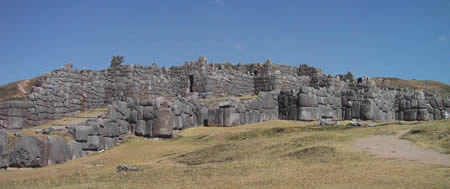
The Inca fortress of Sacsayhuamán
After the Spanish robed all the gold and other valuables, they burned Cusco to the ground. Only the foundations, made by the Incas to overcome earthquakes and time, survived the disaster. Cusco is today most probably the most beautiful city in Latin America. Take care the first day when arriving, you are at 3.400m above sea level and this can be hard if you come from the lowlands, take it easy! (Read more about health problems and heights)
![]()
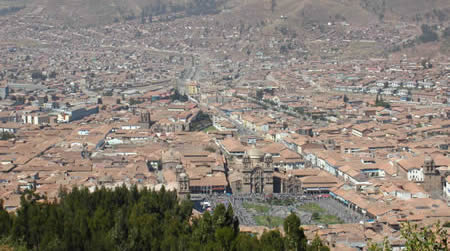
Cusco seen from Sacsayhuamán, the Plaza de Armas is clearly visable in front
Around Cusco
Visiting Cusco is the climax of traveling in Peru. Make sure to foresee enough days to see the city and its surroundings. In and around the city there is so much to see that one needs at least 4-5 days to see the minimum. A city trip includes generally some of the majestic churches and cathedrals (mostly La Catedrál and La Compañía at the Plaza the Armas) and the palace of Inca Garcilaso de la Vega converted to the museum of history of Cusco and some other places in Peru.
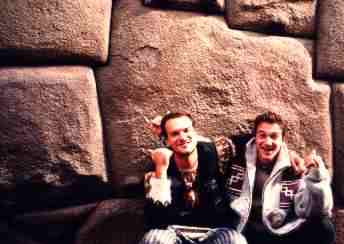 These
buildings can be visited with or without a guide but everybody needs to get a BTG (a
tourist ticket that gives access to the most important tourist building in Cusco
and 8 ruins outside of the city, included the Sacred Valley). The
BTG costs US$ 10 and half the price for student (don't forget your student card of
course). To visiting the Sacred Valley, better get a day ticket in one of the many
agencies on and around the Plaza de Armas. Most of the agencies
work in pool, so it doesn't really matter where you go. Prices are between S./12
and S./25. On the right hand side you can see the famous stone with the 12 corners
at the palace of Inca Roca. The two guys posing are meanwhile older than the stone
and can tell everything about it ;-)
These
buildings can be visited with or without a guide but everybody needs to get a BTG (a
tourist ticket that gives access to the most important tourist building in Cusco
and 8 ruins outside of the city, included the Sacred Valley). The
BTG costs US$ 10 and half the price for student (don't forget your student card of
course). To visiting the Sacred Valley, better get a day ticket in one of the many
agencies on and around the Plaza de Armas. Most of the agencies
work in pool, so it doesn't really matter where you go. Prices are between S./12
and S./25. On the right hand side you can see the famous stone with the 12 corners
at the palace of Inca Roca. The two guys posing are meanwhile older than the stone
and can tell everything about it ;-)
Cusco has excellent nightlife and many pubs and discos offer free tickets on the Plaza the Armas, generally from 8pm until 11pm. At night, the Plaza changes into a market where typical clothes, souvenirs and artisan are sold. Everybody should make a walk by sunset in and around the center of Cusco. The Avenida el Sol is one of the main boulevards. The most important banks, the impressive palace of justice and one block further the Santa Domingo (see picture above) are found in this avenue. This church is also known as the Q'oricancha ("The Gold Walls"). It is where the Inti Raymi festival starts every year the 24th of June. This was the beginning of a new solar year according to the calender of the Incas.
![]()
| Province: | Urubamba, in the department of Cusco |
| Location: | on the eastern slopes of the Vilcanota River, 2.400m above sea level |
| Weather: | subtropical, hot and humid. Av temperature 13°C. Nov-March rainy season, heavy rains, April-Oct dry season, higher temperatures, cool to cold at night |
More about Machu Picchu in our section about The City of Magic
Peru Rail, the private rail company has its own website now, www.perurail.com
Some buildings and cities were never found by the Conquistadors or just left alone because of their uninteresting position. Machu Picchu is the most important place that the Spanish never discovered. Officially the American professor Hiram Bingham found this magical place in 1911. The sacred city and the Incas became very famous since then, the Taj Majal of Latin America and probably one of the most beautiful places in the world. Very little information stood the test of time about Machu Picchu. Archeologists found out that the city was a religious place of pilgrimage, constructed in the 15th and the first half of the 16th century and was probably never finished. It could be that their work was interrupted by the Spanish invasion or the civil war just before the conquista between Atahualpa and Huascar.
Visit Machu Picchu! One of the 7 Wonders of the World and enjoy the comfort of the best Machu Picchu Hotels.
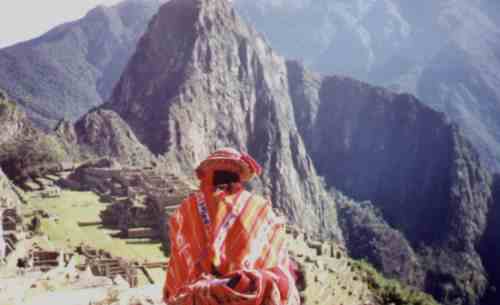
The city is divided in two halves, a religious and a residential area with a relative big square in the middle. Approximately 1200 men could live in Machu Picchu and six men were enough to guard the city. Built on a steep mountain and surrounded by sub-tropical rainforest gives every visitor the feeling of being save and untouchable.
Next to the Machu Picchu (old mountain) is the Huayna Picchu (young mountain) and can be visited. A climb of at least 30 minutes brings you on top of this very steep mountain. You need good physical condition and watch your steps. From this place Machu Picchu can be seen in the shape of a huge condor flying to the West. (Read more about the place and shape of the Sacred City) On top of the Huayna Picchu, temples and terraces were constructed and halfway on the other side of the mountain you can visit the Temple of the Moon, known as the only Inca Temple still intact. Earthquakes did unfortunately destroy most of the other temples on the Huayna Pichu.
This magical place can still be visited by the original Inca Trail. The shortest track is in 2 days (from km 104) and the most popular is the 4-day track from Ollantaytambo in the Sacred Valley. Make sure you have a good condition, solid shoes and in rainy season a raincoat. The second day is the hardest with a 1000m-climb to a pass of 4.300m. It is tricky to do the 4-day track without a guide, but the 2 days-trail can be done alone. In dry season, when the sun is burning hot, you have to make sure to have enough water with you! You'll lose sweat by the liter… Equipment like tents and sleeping bags can be rented at the agencies in Cusco.
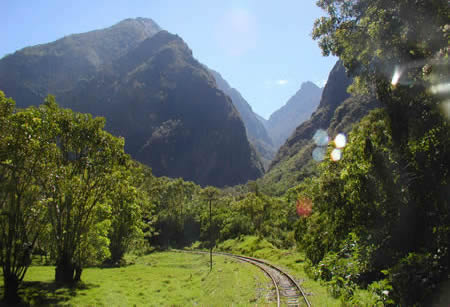
the railroad to Aquas Calientes offers specacular vieuws
The Inca Trail crossed the whole empire and was described by the chroniclers as the best roads they had ever seen. Although the Incas didn't know how to build stone bridges, their trails constituted one of the best communication systems of their time. Fish from the ocean arrived two hours later in Cusco. Messages and quipus from all over the empire got quick and save in Cusco. The quipus are a mathematical account system used to administer the empire. A quipu was composed of colored strings and knots. The runners or chaskis ran distances from 200m to 5km, depending on the difficulty of the terrain. Another chaski took over the message and the goods, similar to the relay race.
Enjoy your Peru family vacations with us, Peru is the perfect choice to bring your whole family and have a great time!
Although it is a hard physical exercise to do the four-day Inca Trail, the magnificent views of white mountains, glaciers, sub-tropical rainforest and the Inca ruins on the way compensate the effort many times. A chaski can be hired to carry part of your luggage. This is generally not included in the service sold by an agency, but has to be arranged by your agency or on location and is additional. Don't worry about these people and their strength. In our group once a female 16-year-young chaski carried the rucksacks of three people and climbed over a mountain pass of 4.300m while telling stories with a smile on her face.
When doing the two-day track, a simple hotel can be found on your way to Machu Picchu. There is a (quit expensive) restaurant and generally people sleep on the floor in their sleeping bags. A room can be rented, but there are few rooms. The next morning the first people leave at 5 o'clock to arrive one hour later at the Inti Punctu or the Gate of the Sun where Machu Picchu can be seen. Then it is a 20 minutes walk to the entrance of the city.
Machu Picchu can also be visited in one day by train. Recently a helicopter service can bring you on location in 25 minutes, but this is a relative expensive option. The train is one of the most spectacular in the world. First the train leaves the valley of Cusco in zigzag. Then the route continues to and through the Sacred Valley of the Urubamba River and make important stops in Ollantaytambo and Aquas Calientes. The vegetation changes from plateau vegetation to sub-tropical forest. In Aquas Calientes a bus service brings you to the gates of Machu Picchu or you can go by foot (800m steep climbing and free). The entrance of the ruin itself is half the price for students.
Read more about the history, location and magic of Machu Picchu.
Related Links: Cusco Information - Cuzco - Cusco Hotel - Cusco Travel
| Cusco
External links
|
|
|
©2024 InfoPeru Best 1024 x 768 |
| Top | Cities | Machu Picchu | Inti Ramyi | Inca Trail | Incas | Email | Sitemap | About |
162873 visits
|
||||||||||||||||||||||||||
